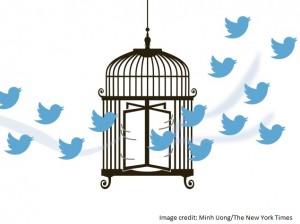 Twitter’s chief executive, Dick Costolo, has replaced virtually every crucial executive at the company in the last few months as he has struggled to figure out how to get more people using the service.
Twitter’s chief executive, Dick Costolo, has replaced virtually every crucial executive at the company in the last few months as he has struggled to figure out how to get more people using the service.
The chief operating officer? Gone. The head of product? Out. The top engineer? Fired.
On Tuesday, Costolo again spun the revolving door, bringing in Anthony J. Noto, the star Goldman Sachs banker who helped Twitter sell its initial stock offering last fall, as the chief financial officer of the microblogging company.
While Noto is respected on Wall Street, he probably will not be much help with Twitter’s fundamental problem: How to make a niche service, with its quirky abbreviations like RT and MT and endless flow of 140-character text messages, into something that appeals to the masses.
Twitter had 255 million monthly users globally in March, up 5.8 percent from the end of December. Analysts had hoped to see more than 260 million. Growth at the end of last year was even slower.
That has disappointed investors who bought shares after the company’s initial public offering, believing that Twitter had the potential to become as big as Facebook, which has five times as many users.
(Also see: Twitter COO Ali Rowghani Resigns Amid Lacklustre Growth)
“How do you convince my mom she needs to use Twitter? Facebook is obvious. Everyone likes to share pictures and message their friends,” said Richard Greenfield, a media analyst at BTIG Research. “If they want to reach everybody in the world like Facebook does, the product is going to have to change pretty significantly.”
The continuing turmoil in the executive suite, a hallmark of the company throughout its eight-year existence, suggests that Twitter is struggling to find its footing as competition from Facebook stiffens.
“It’s unusual to have this kind of management shuffle and turnover so soon for a public company,” said Mark Mahaney, an Internet analyst at RBC Capital Markets. “It just highlights there is still a lot of management risk here. They wouldn’t be making all of these shuffles if they were perfectly jelling.”
Twitter declined to comment beyond its securities filing announcing the leadership change.
One thing Twitter has gotten right so far: It has become a household name.
Twitter’s great strength is bringing people together around events, whether it is to follow news updates and eyewitness reports during a tragedy like the bombing at the Boston Marathon in 2013 or to commune electronically with millions of fellow Super Bowl fans each winter as the game unfolds.
The company has worked with media outlets, television networks and advertisers to make its brand ubiquitous during those moments.
The resulting publicity – remember the selfie that Ellen DeGeneres posted on Twitter when she hosted the Oscars this spring? – prompts a large influx of new users to check out the service.
The challenge is in getting those newcomers to stay. To get real value out of the service, a user has to invest a lot of effort up front, be it deciding which accounts to follow or determining how to sift useful bits of information from the irrelevant chatter that can easily fill up each person’s feed.
“If Twitter made a dime after every time someone mentioned it on TV, they’d be where they want to be,” said Nate Elliott, a technology analyst at Forrester Research.
At the World Cup soccer tournament, Twitter has experimented with changing the user sign-up experience. Newcomers are prompted to follow the Twitter accounts of players and teams participating in the matches. The idea is that if new users can easily follow Twitter discussions about the popular games, they will understand the value of the service and keep returning long after the last goal is scored.








